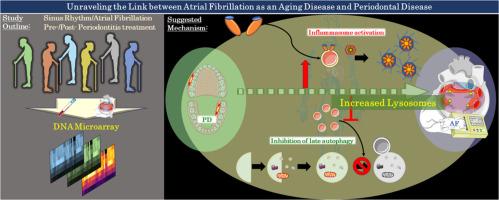Association between atrial fibrillation and periodontal disease: A bioinformatics analysis
引用次数: 0
Abstract
Introduction
Atrial fibrillation (AF), which is an aging disease, and periodontal disease (PD) are prevalent, and AF and PD may be associated with each other. Inflammation plays a role in the two pathologies. However, there is a need for a deeper understanding of the mechanisms associated with these conditions.
Methods
A bioinformatics analysis was performed to compare gene expression profiles in the blood and left atrial tissue samples of patients with AF and in the blood samples of patients with PD. Our analysis involved comparing gene expression profiles between patients with AF, those with sinus rhythm, and individuals with and without PD. This comparative approach enabled us to identify upregulated genes in both the AF and PD cohorts.
Results
The expression of 40 genes was upregulated in patients with AF and PD, with a significant enrichment for genes associated with inflammation. Notably, a network analysis revealed distinct functional associations among these genes. Interestingly, the expressions of three lysosome-related genes in all analyzed tissues (AF blood, PD blood, and AF left atrium) were upregulated.
Conclusion
Inflammation played a role in AF and PD. Further, based on the upregulated expression of lysosome-related genes across all samples that were evaluated, in addition to inflammation, lysosomal function had a possible role in the co-existence of the two diseases.

心房颤动与牙周病之间的关系:生物信息学分析
导言 心房颤动(房颤)是一种老年性疾病,而牙周病(牙周病)则是一种流行病,房颤和牙周病可能相互关联。炎症在这两种病症中都起到了一定的作用。我们进行了一项生物信息学分析,以比较房颤患者血液和左心房组织样本中的基因表达谱和牙周病患者血液样本中的基因表达谱。我们的分析包括比较房颤患者、窦性心律患者以及有和没有帕金森病的个体之间的基因表达谱。结果40个基因的表达在心房颤动和帕金森病患者中上调,其中与炎症相关的基因显著富集。值得注意的是,网络分析显示这些基因之间存在不同的功能关联。有趣的是,三个溶酶体相关基因在所有分析组织(房颤血液、帕金森病血液和房颤左心房)中的表达均上调。此外,根据所有评估样本中溶酶体相关基因的上调表达,除炎症外,溶酶体功能也可能在这两种疾病的并存中发挥作用。
本文章由计算机程序翻译,如有差异,请以英文原文为准。
求助全文
约1分钟内获得全文
求助全文

 求助内容:
求助内容: 应助结果提醒方式:
应助结果提醒方式:


